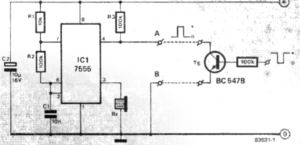There are many situations where an audible indication for a button pressed would be very useful. Two particular cases are: a morse key, where it is otherwise impossible to know that the key has been operated, and an ASCII keyboard. This circuit is based on a 7555 timer IC (the CMOS version of the well known 555) which is connected as an astable multivibrator (ANIV). Its output is a square wave at a frequency of about 700 Hz and is used to drive* a small buzzer. The circuit will be prevented from oscillating if pin 4 of the IC is taken to 0 V, in other words, a short between points A and B in the circuit diagram.
As mentioned, the key bleep is ideal for use as a key push indicator with the ASCll keyboard. In this case a tone will be produced each time the key is pressed making it unnecessary to continually look at the screen to verify correct operation Don't worry, only one key bleep circuit is needed, not one for each key of the keyboard! The circuit can be controlled by the strobe pulse which can, of course, be either a logic ’1’ or a logic 'O’. if it is a '1’ the strobe can be connected directly to point A. lf on the other hand, it- is a 'O' then the transistor stage TS y will have to be connected between points A and B. The strobe output is then- fed directly to the base of transistor `l'S. If the circuit is to be used with ya morse key,"the transistor stage TM is required. The emitter and collec- tor of the transistor are connected to points A and B and the key is placed between its base and 0 V.


Leave a Reply